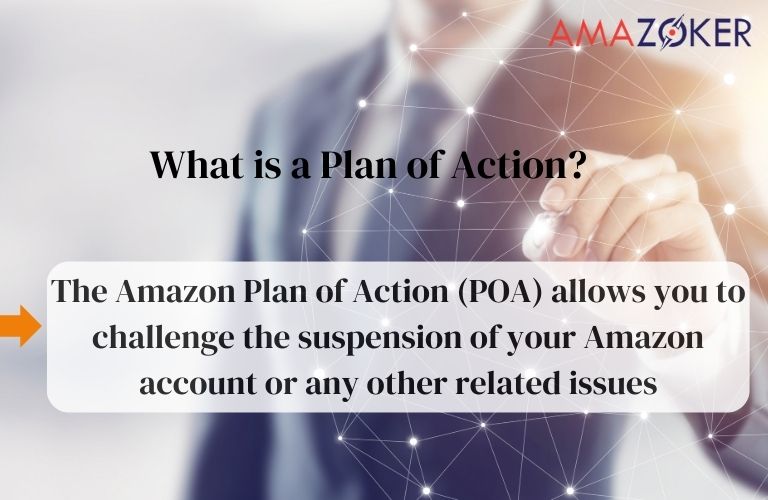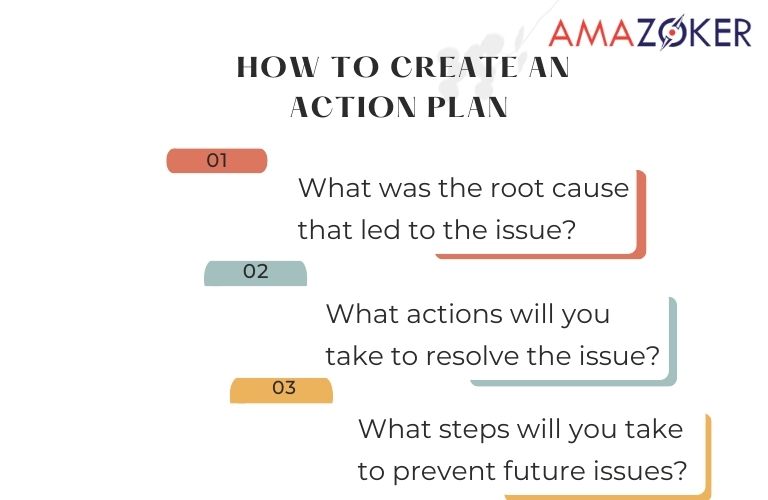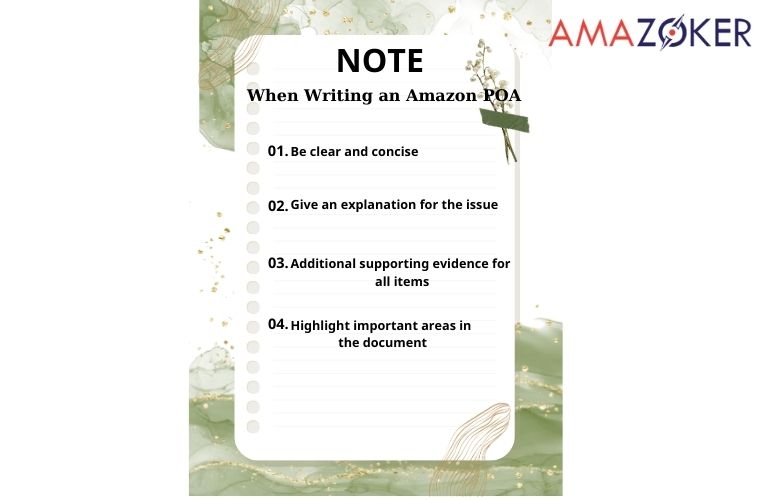As an Amazon seller, encountering issues with your account, create an Amazon plan of action (POA) and submitting it to Amazon can be instrumental in restoring your account. Therefore, understanding and accurately crafting a POA template is crucial. It serves as a pivotal step in ensuring the continuity of your business on this platform.
Table of Contents
What is a Plan of Action?
The Amazon Plan of Action (POA) serves as a tool for contesting the suspension of an Amazon account or addressing related issues. Despite its intended purpose, many Amazon merchants find it challenging to navigate. Sellers are instructed by Amazon to submit an appeal through a created Plan of Action, but specific details regarding its structure, format, and content guidelines are not explicitly provided.

The amazon plan of action allows you to challenge the suspension of your account
The Plan of Action functions as the appeal for account reinstatement. Even though account restoration is entirely dependent on the outcome of the appeal, there are no specific conditions.
How do you create an Amazon plan of action
A plan of action amazon must answer three following questions as same as Amazon appeal plan of action template:
What was the root cause that led to the issue?
Clearly identify and articulate the specific root cause that led to the issue. Be detailed and precise in your explanation. Avoid generalizations and provide evidence or data supporting your understanding of the root cause.
What steps do you plan to undertake to address the problem?
Outline a step-by-step plan to address and resolve the identified issue. Detail the actions you have already taken or plan to take to rectify the situation. Include specific dates, actions, and any supporting documentation that demonstrates your commitment to resolving the problem.
What steps will you take to prevent future issues?
Lay out a proactive strategy to prevent similar issues from occurring in the future. This should include concrete steps, procedures, or changes in processes that will be implemented to ensure ongoing compliance. Emphasize a commitment to continuous improvement and adherence to Amazon’s policies.

Steps to create a successful amazon plan of action
Professional Templates for Amazon Plan of Action
The purpose of this professional template is to provide a comprehensive outline for Amazon’s action plan to address policy violations effectively. These Amazon plan of action examples serve as guide for Amazon’s teams involved in policy enforcement, ensuring a consistent and structured approach to resolving policy violations and maintaining a fair and trusted marketplace.
Addressing Product Quality Issue
Maintaining the highest standards of product quality is paramount for Amazon sellers to ensure customer satisfaction and platform compliance. This will help create an action plan template for sellers facing challenges related to product quality on the Amazon marketplace.
Identification of the Issue
- Begin by precisely defining the specific product quality concern, whether it stems from customer complaints, negative reviews, or internal monitoring.
- Explore the various sources of the issue to understand its scope and impact on the seller account.
Root Cause Analysis
- Conduct a thorough examination to identify the root causes behind the quality issue.
- Pinpoint any lapses in quality control, manufacturing processes, or sourcing that contributed to the problem.
Immediate Corrective Actions
- Outline the swift and decisive measures taken to address and rectify the identified quality problem.
- Highlight temporary steps such as halting sales, conducting inventory reviews, and implementing immediate corrective actions to prevent further complications.
- Emphasize transparent communication with customers regarding the quality issue.
- Detail how customer concerns are being addressed, whether through refunds, replacements, or other corrective actions, ensuring overall customer satisfaction.
Long-Term Preventive Measures
- Showcase a commitment to preventing future occurrences by implementing sustainable strategies.
- Detail long-term initiatives, such as enhancing quality control processes and implementing rigorous supplier vetting procedures.

Template is to provide a comprehensive outline to address violations effectively
Addressing Policy Violation
This action plan outlines the steps and strategies that Amazon employs to identify, investigate, evaluate, and address policy violations promptly. By following this plan, Amazon aims to ensure a high level of compliance, trust, and customer satisfaction.
Identify the Policy Violation
Clearly understand the specific policy that was violated and the reasons behind it. Carefully review Amazon’s policies and guidelines to ensure a thorough understanding.
Assess the Root Cause
Determine the root cause of the policy violation. Was it due to a misunderstanding, an oversight, or a lack of awareness? Identifying the underlying cause will help you develop effective solutions.
Take Immediate Corrective Actions
Address the policy violation promptly by taking corrective measures. This may involve removing or revising non-compliant listings, discontinuing prohibited practices, or resolving any customer complaints related to the violation.
Prevent Future Violations:
- Develop a proactive strategy to prevent similar policy violations in the future. This may include implementing stricter quality control measures, enhancing product information accuracy, or conducting regular compliance audits.
- Invest time in understanding Amazon’s policies and guidelines thoroughly. Educate yourself and your team members about the policies relevant to your business to ensure ongoing compliance.
- Continuously monitor your account’s performance and review any warnings or notifications received from Amazon. Analyze the data to identify any potential policy violations or areas of improvement that need attention.
- If you are uncertain about any policy requirements or need assistance in implementing corrective actions, consider seeking professional guidance. Amazon offers resources such as Seller Support or you can consult with experienced professionals familiar with Amazon’s policies and best practices.
Addressing Intellectual Property Complaints
Intellectual property complaints refer to allegations of infringement on copyrighted works, trademarks, patents, or other forms of IP. These complaints are raised by rights holders who believe their IP rights have been violated by sellers on the Amazon platform.
Addressing intellectual property (IP) complaints requires a systematic and careful approach to protect the rights of all parties involved. Below is a general plan of action that can be adapted based on the specific nature of the IP complaint:
Complaint Review and Analysis
- Promptly reviewing and acknowledging intellectual property complaints
- Examine the complaint thoroughly to understand the specific allegations and claims.
- Identify the intellectual property rights involved (e.g., copyright, trademark, patent).
- Collect relevant documents, agreements, and evidence related to the disputed content or product.
- Verify the identity of the complainant and their ownership of the intellectual property rights.
Immediate Corrective Actions
- Seek legal advice from intellectual property attorneys to understand the legal implications and potential courses of action.
- If the complaint is found to be valid, take immediate action to cease or modify the infringing activity.
- Consider negotiating with the complainant to reach a resolution.
- Compose a formal reply that thoroughly addresses each raised point in the complaint.
- Clearly articulate the company’s position and any corrective actions taken.
- Evaluate legal remedies available to address the complaint, such as licensing agreements, settlements, or dispute resolution mechanisms.
Preventive Measures
- Develop and implement policies and procedures to prevent future intellectual property issues.
- Educate employees on intellectual property laws and compliance.
- Keep the complainant informed of the progress and resolution of the matter.
- Maintain open lines of communication to foster a cooperative environment.
Addressing Performance Metrics Issue
Identification of Performance Metric Issue
- Clearly define the underperforming metric(s) such as order defect rate, late shipment rate, or other relevant metrics.
- Identify the specific time and instances contributing to the decline in performance.
Root Cause Analysis
- Conduct a thorough analysis to understand the root causes behind the performance metric issue.
- Identify any internal processes, communication breakdowns, or logistical challenges that may have contributed to the problem.
Immediate Corrective Actions
- Outline swift measures to address and rectify the identified performance metric issue.
- Implement immediate corrective actions, such as improving communication with customers, addressing order fulfillment bottlenecks, or adjusting inventory management.
- Communicate proactively with affected customers, explaining the corrective actions taken.
- Establish transparent communication channels with Amazon, providing insights into the addressed issues and outlining steps taken for improvement.
Long-Term Preventive Measures
- Demonstrate a commitment to preventing future occurrences by implementing sustainable strategies.
- Implement process enhancements, additional training, or workflow improvements to ensure long-term compliance with performance metrics.
- Establish a system for ongoing monitoring of performance metrics.
- Commit to continuous improvement, regularly reviewing and adjusting strategies to maintain positive performance.
Key Considerations When create an Amazon plan of action
Be clear and concise: Your plan of action amazon should be straightforward and factual. Focus on presenting the facts and events that led to the issue rather than providing an introduction to your product, business, or customer. Other inquiries or references to open support cases should be removed from your contribution. Use non-emotional wording whenever possible.
Give an explanation for the issue: Deactivations can occur as a result of a number of factors (for example, a High Order Defect Rate can arise from negative feedback and undelivered orders). In your plan of action, you must present a reaction to each underlying cause.
Additional supporting evidence for all items: Ensure you include supporting proof for all the goods or ASINs that are being considered. The list of products can be found at the bottom of your initial notification. Review the timeline specified for the requested documents, as some may necessitate invoices from the past 365 days.

Key factors contribute to a successful appealing when writing an Amazon plan of action
Enhance the relevance of your response by emphasizing crucial areas in the document. Consider circling or underlining vital elements, such as ASINs and supplier data (such as name and website), or terms in your Terms and Conditions.
Conclusion
In conclusion, while navigating the challenges to create an Amazon Plan of Action may seem daunting, it is crucial to approach it with a solution-oriented mindset. Despite the complexity of the situation, a successful POA need not be convoluted. By simplifying your approach and focusing on practical solutions rather than assigning blame, you can effectively address specific issues and work towards reinstating your seller account.
And for those finding the management of Amazon suspensions and policy changes challenging or time-consuming, there’s a convenient solution. By using Amazoker service today, you can experience significant growth for your Amazon business without the hassle. Embracing this alternative can streamline your operations and allow you to focus on what matters most – the success of your Amazon store.












